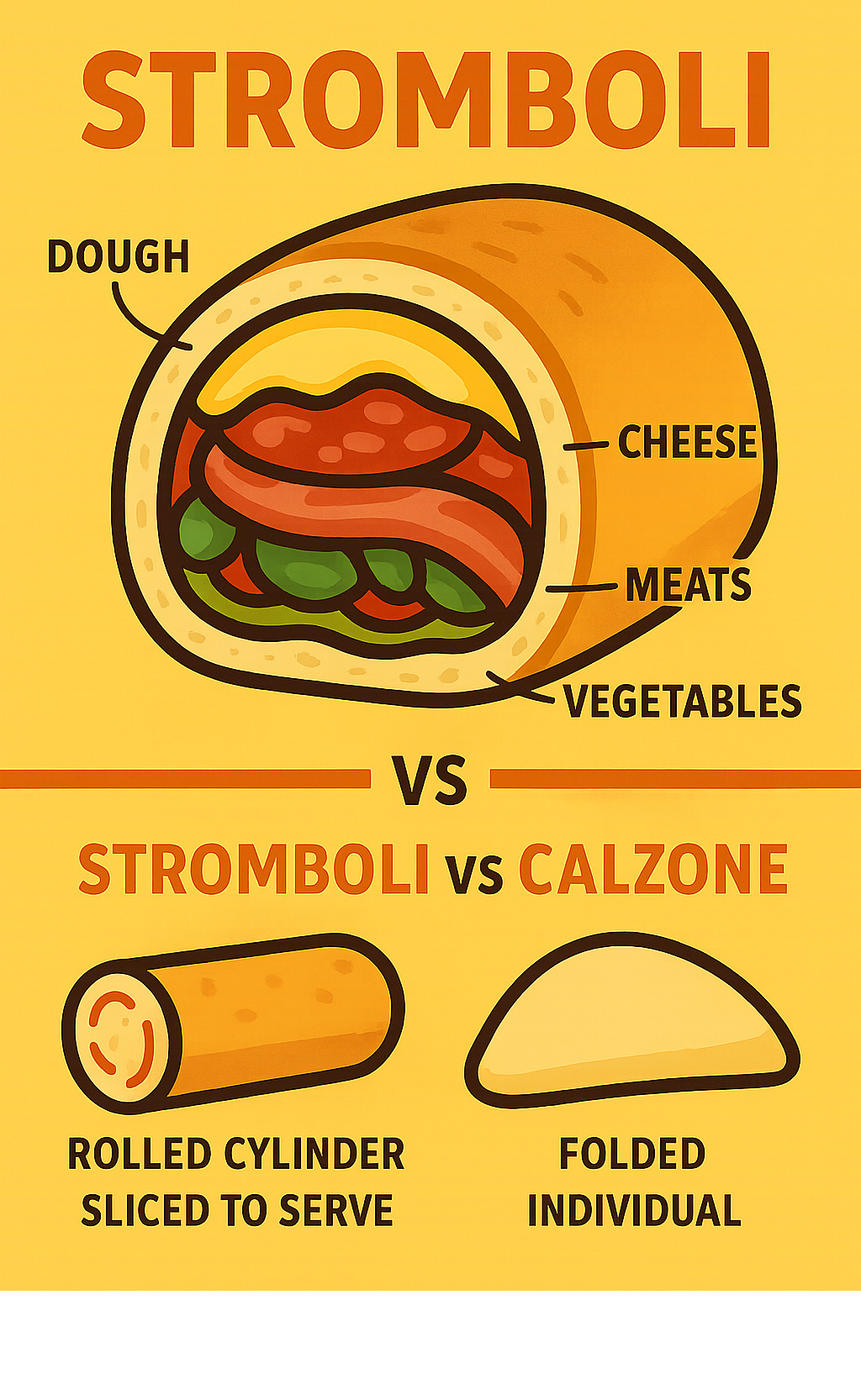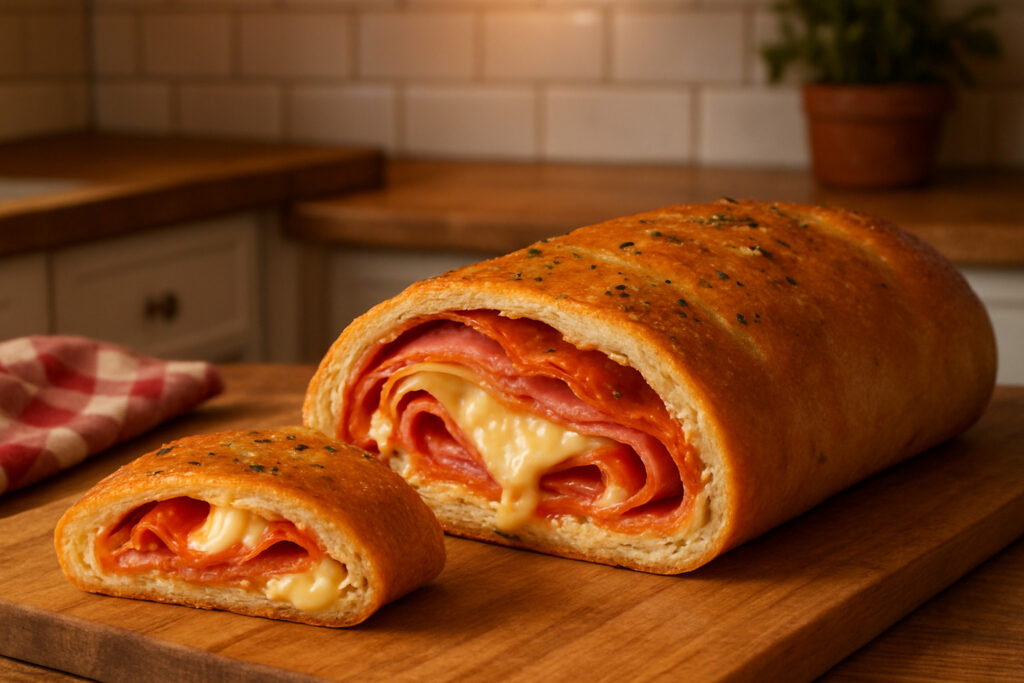What Is Stromboli and Why Food Lovers Adore It
Stromboli is a rolled Italian-American turnover filled with cheese, meats, and vegetables, then baked until golden brown. Think of it as pizza’s portable cousin – all your favorite pizza flavors wrapped up in a sliceable log that’s perfect for sharing.
Quick Stromboli Facts:
- Origin: Philadelphia, 1950s (not Italy!)
- Shape: Rolled cylinder, sliced to serve
- Key difference from calzone: Stromboli is rolled; calzone is folded
- Typical fillings: Mozzarella, Italian meats, vegetables
- Serving style: Hot, sliced, often with marinara for dipping
- Prep time: 30-50 minutes total
This Italian-American creation has become a beloved comfort food across the United States. Unlike its Italian cousins, stromboli was born in a Philadelphia pizzeria when restaurant owner Nazzareno Romano experimented with “pizza imbottita” (stuffed pizza) in 1950.
The beauty of stromboli lies in its versatility. You can stuff it with classic pepperoni and mozzarella, go gourmet with prosciutto and provolone, or create vegetarian versions with spinach and feta. It’s become a game-day favorite because it feeds a crowd and travels well.
Whether you’re exploring Italian-American cuisine or planning your next culinary trip, understanding stromboli opens doors to a whole world of stuffed bread traditions found in pizzerias from New York City to small-town America.

Stromboli terms made easy:
The Story Behind Stromboli
Picture this: it’s 1950 in Essington, Pennsylvania, and Italian immigrant Nazzareno Romano is tinkering around in his pizzeria kitchen. Romano, who owned Romano’s Italian Restaurant & Pizzeria, wasn’t trying to make culinary history – he was just experimenting with different ways to serve pizza to his American customers.
Romano had been working with “pizza imbottita” (stuffed pizza), rolling dough around cheese and meats instead of laying toppings on top. It was delicious, but it needed a name. That’s when his brother-in-law suggested they call it “stromboli” after the Ingrid Bergman movie that was causing quite the scandal at the time.
The timing was perfect. Post-World War II America was falling in love with Italian-American cuisine, and stromboli fit right into this delicious cultural evolution. Italian immigrants like Romano were taking their grandmother’s recipes and giving them an American twist, using ingredients they could easily find.
What Romano created wasn’t just tasty – it was substantial. A typical homemade stromboli packs between 237 and 418 calories per slice, with a hearty 10-21 grams of protein. The classic version uses about half to one pound of Italian cold cuts and three-quarters to a full pound of cheese per roll.
How Stromboli Got Its Name
The connection to Ingrid Bergman’s film “Stromboli” wasn’t just about riding the wave of Hollywood buzz. The name also captured something essential about the dish itself.
The original Stromboli is a volcanic island off Sicily’s coast, nicknamed the “Lighthouse of the Mediterranean” because its fiery eruptions have been visible from the sea for over 2,000 years. Romano’s brother-in-law was onto something brilliant with this comparison.
When you slice into a perfectly made stromboli, the melted cheese and sauce practically erupt like lava from that famous volcano. It’s hot, it’s dramatic, and it’s absolutely irresistible.
Stromboli vs Traditional Italian Bakes
While stromboli was born in Pennsylvania, it definitely has Italian DNA running through its cheesy veins. Sicily has scaccia – thin dough rolled around various fillings. Down in Southern Italy, there’s panzerotto, often deep-fried and sharing that same “stuff-it-all-inside” philosophy.
These regional influences traveled across the ocean during the great waves of Italian immigration. Italian-American cooks like Romano took these time-tested techniques and adapted them for their new lives, creating something that honored their heritage while establishing an entirely new tradition.
Stromboli vs. Calzone & Pizza
If you’ve ever stood in a pizzeria wondering what makes stromboli different from its Italian cousins, you’re not alone. While these three dishes share the same DNA of dough, cheese, and delicious fillings, they’re actually quite different creatures.
The most obvious difference hits you right in the shape. Stromboli gets rolled up like a delicious log and then sliced for serving – perfect when you’re feeding a hungry crowd. Calzones, on the other hand, are folded into those classic half-moon pockets that are sized just right for one person. And pizza? Well, pizza stays flat and gets cut into those familiar triangular slices we all know and love.
But the real magic happens in how the fillings are distributed. When you make stromboli, you layer all your ingredients evenly across the dough before rolling it up. This means every single bite delivers the full flavor experience – cheese, meat, and vegetables all perfectly balanced. Calzones stuff everything into that pocket, which can sometimes mean you get a bite of mostly cheese followed by a bite of mostly pepperoni.
The sauce situation tells its own story too. Stromboli sometimes includes a thin layer of sauce inside, but it’s usually served with marinara on the side for dipping. Calzones traditionally keep their sauce on the side as well, while pizza makes the sauce part of the foundation.
| Feature | Stromboli | Calzone | Pizza |
|---|---|---|---|
| Shape | Rolled log | Half-moon pocket | Flat circle |
| Serving | Sliced for sharing | Individual portions | Sliced triangles |
| Sauce | Usually on side | On the side | Integrated base |
| Cheese | Mozzarella dominant | Often includes ricotta | Various types |
| Origin | Philadelphia, 1950s | Naples, Italy | Naples, Italy |
The moisture management game is where stromboli really shows its cleverness. The rolling technique and the types of cheeses used (usually mozzarella and provolone) create a dish that holds together beautifully without getting soggy.
Key Differences in One Bite
When you bite into a properly made stromboli, you’re experiencing layers of flavor that spiral through each slice. The rolling creates this beautiful pattern where the crispy exterior gives way to perfectly distributed cheese and meats. It’s like unwrapping a present with every bite.
A calzone bite tells a different story entirely. Since you’re eating from a pocket, you might hit a cheese pocket in one bite and a meat section in the next. There’s nothing wrong with this – it’s just a different eating experience that keeps you guessing.
The cheese choices reveal another key difference. Stromboli makers typically stick with mozzarella and provolone – cheeses that melt smoothly and don’t release too much moisture during baking. Calzones often feature ricotta, which adds that signature creaminess but behaves completely differently when heated.
Why Stromboli Wins Game Day
There’s a reason stromboli has become the ultimate game-day hero, and it’s not just because it tastes incredible. One stromboli can easily feed six to eight hungry people when sliced, making it perfect for parties where you want to keep things simple but satisfying.
The portability factor is huge for food lovers who want great flavors without the fuss. Stromboli travels like a champion and can even be served at room temperature if needed – try doing that with pizza! It doesn’t need special serving equipment or plates. Just slice and watch people dive in.

But here’s where stromboli really shines: it’s built for dipping. Those perfectly sliced pieces hold up beautifully to marinara sauce without falling apart or getting soggy. This interactive eating experience turns every game day or gathering into a social event where everyone’s reaching for that next perfect bite.
How to Make Stromboli Step-by-Step
There’s something magical about making stromboli at home – the way your kitchen fills with that irresistible aroma of baking bread and melted cheese. Don’t worry if you’re new to this; stromboli is surprisingly forgiving and much easier than it looks.
The beauty of homemade stromboli lies in choosing your own trip with the dough. You can go the traditional route with homemade pizza dough, which needs about 60-90 minutes of rise time but gives you that perfect chewy texture. If you’re short on time, store-bought dough works beautifully and cuts your prep time in half.
Here’s what makes stromboli foolproof: you’re essentially making a rolled sandwich that bakes itself into golden perfection. Roll the dough into a rectangle, layer your favorite fillings, roll it up like a jelly roll, seal the edges, and bake at 400°F for 25-35 minutes. Your instant-read thermometer should hit 200°F at the center when it’s perfectly done.
The classic stromboli lineup includes 1 pound of pizza dough, 8 oz mozzarella cheese, 4 oz provolone cheese, 4 oz pepperoni, 4 oz salami or ham, plus 1 beaten egg for that glossy finish and marinara sauce for dipping.
Choosing & Handling Dough
The secret to amazing stromboli starts with understanding your dough. If you’re making from scratch, bread flour is your best friend because its higher protein content develops stronger gluten. This means your dough won’t tear when you’re rolling and stretching it.
Want to test if your homemade dough is ready? Try the windowpane test – stretch a small piece thin enough to see through without it falling apart.
Store-bought dough is honestly fantastic and saves you so much time. The key is letting refrigerated dough come to room temperature for about 30 minutes before you start rolling. Cold dough is stubborn, but room-temperature dough rolls out like a dream.
When you’re ready to roll, use a lightly floured surface and work from the center outward. Just aim for relatively even thickness (about 1/4 inch) so your stromboli bakes uniformly.
Rolling, Filling & Sealing Stromboli
This is where the fun really begins. Rolling technique is what separates a beautiful stromboli from a filling-leaking disaster, but it’s easier than you think.
Start by rolling your dough into a rectangle, leaving about a 2-inch border on all sides. This border is your insurance policy for keeping all those delicious fillings inside where they belong.
Layer your ingredients like you’re building something beautiful. Begin with a thin layer of olive oil and garlic, then add your cheeses, followed by your meats. Here’s a crucial tip: avoid watery vegetables like fresh tomatoes or raw mushrooms unless you’ve cooked and drained them first.
The Scientific research on pizza dough stretching shows that proper gluten development prevents those heartbreaking tears during rolling. Layer your ingredients like roof shingles for even distribution.
When you’re ready to roll, start from one long edge and roll firmly but gently. Pinch the seam closed and tuck the ends under, then place seam-side down on your baking sheet.
Baking for Best Results
The final stretch is where your stromboli transforms from a stuffed log into golden, aromatic perfection. Preheat your oven to 400°F and line a baking sheet with parchment paper.
Before your stromboli hits the oven, brush the top with beaten egg for that gorgeous, glossy finish. Then make 3-4 diagonal slits about 1/4 inch deep across the top. These are steam vents that prevent your stromboli from bursting open.
Bake for 25-35 minutes, and rotate the pan halfway through for perfectly even browning. Your stromboli is ready when it’s deep golden brown and that instant-read thermometer hits 200°F in the center.
For restaurant-quality flavor, brush the hot stromboli with melted butter, garlic, and Italian seasoning the moment it comes out. Then let it rest for 10-15 minutes before slicing to prevent a molten cheese avalanche.
Make-Ahead, Freezing, Storage & Reheating
Planning ahead with stromboli is one of its greatest superpowers. Whether you’re hosting a dinner party or just want to meal prep for the week, this Italian-American favorite works beautifully with your schedule.
You can assemble your stromboli completely up to 8 hours before baking. Just wrap it tightly in plastic wrap and pop it in the fridge. When you’re ready to serve, simply brush with egg wash, make those steam slits, and bake as usual.
For longer-term planning, stromboli is a freezer champion. Properly wrapped, it stays fresh for up to 3 months in the freezer. The trick is assembling everything but holding off on the egg wash and steam slits until baking day. Wrap your unbaked stromboli first in plastic wrap, then in aluminum foil.
When you’re ready to enjoy your frozen stromboli, it needs a full 24 hours in the refrigerator to thaw properly. Once thawed, add your egg wash and make those important steam vents before baking normally.

Already baked stromboli keeps beautifully in the fridge for 3-4 days. For the best reheating results, wrap individual slices in foil and warm them in a 200°F oven for about 10 minutes.
The budget-conscious cook will love stromboli’s batch-cooking potential. Making two at once barely adds any prep time, and you can freeze one for later. At roughly $8-12 per stromboli that serves 6-8 people, you’re looking at incredibly economical meals.
Avoiding Common Mistakes
Even experienced home cooks can stumble with stromboli, but these pitfalls are easy to avoid once you know what to watch for.
Overstuffing is the number one culprit behind burst seams and uneven cooking. Stick to about 1 to 1.5 cups of filling per pound of dough – your stromboli will hold together beautifully and cook evenly.
Soggy crust breaks hearts and ruins dinner plans. The main villain here is excess moisture from ingredients like fresh mushrooms or peppers. Always cook and drain watery vegetables first, and blot fresh mozzarella with paper towels before using it.
Under-baked centers are more common than you’d think. That gorgeous golden exterior can fool you, but the inside might still be doughy. Don’t guess – use an instant-read thermometer. The center should hit 200°F for perfectly cooked stromboli.
Serving Temperature & Party Tips
Here’s where stromboli really shows off its versatility – it’s genuinely delicious at different temperatures. Hot from the oven with molten cheese is obviously divine, but it’s even great at room temperature for picnics or buffet-style serving.
For parties, consider making several smaller stromboli instead of one giant one. This strategy lets you offer different flavor combinations while making serving much easier.
Presentation lifts your stromboli from casual dinner to impressive entertaining. Slice each roll into 1-inch thick pieces and arrange them on a wooden cutting board. Add small bowls of warm marinara sauce for dipping, garnish with fresh basil, and provide small spoons for the sauce.
Creative Fillings, Vegetarian Spins & Pairings
The magic of stromboli really shines when you start experimenting with different fillings. While those classic Italian combinations of pepperoni and mozzarella will always have their place, there’s a whole world of flavors waiting to be rolled up in that golden dough.
Think beyond the traditional Italian deli counter. Buffalo chicken stromboli has become a crowd favorite – just mix shredded chicken with buffalo sauce, add some blue cheese crumbles, and maybe a touch of celery for crunch.
For something unexpected, try a breakfast stromboli filled with scrambled eggs, crispy bacon, breakfast sausage, and sharp cheddar cheese. It’s perfect for weekend brunches or when you want to impress houseguests.
Pesto opens up another flavor dimension entirely. Spread a thin layer of basil pesto on your dough, then add grilled chicken, sun-dried tomatoes, and fresh mozzarella. The herbaceous pesto creates a gourmet experience.
The key to successful creative fillings is understanding moisture management. Watery vegetables can turn your beautiful stromboli into a soggy mess, so always cook and drain ingredients like mushrooms, peppers, or spinach before adding them.
Stromboli for Every Diet
Vegetarian stromboli can be just as satisfying as the meat-filled versions. Spinach and feta makes an incredibly flavorful combination – the salty, tangy feta pairs beautifully with earthy spinach, especially when you add some sun-dried tomatoes for sweetness and texture.
Roasted vegetables bring amazing depth to vegetarian stromboli. Try roasting eggplant, zucchini, and red bell peppers until they’re caramelized and tender, then pair them with goat cheese and fresh herbs. The roasting process concentrates the vegetable flavors and removes excess moisture.
Vegan cheese alternatives have come a long way in recent years, making plant-based stromboli more delicious than ever. Cashew-based mozzarella melts beautifully, while nutritional yeast adds that savory, cheese-like flavor.
For those following low-carb lifestyles, you can capture the essence of stromboli by wrapping the traditional fillings in large collard green leaves or low-carb tortillas. While it’s not quite the same as that crispy, chewy crust, it delivers all those familiar flavors in a lighter package.
Gluten-free dough options mean that people with celiac disease or gluten sensitivity don’t have to miss out. Many grocery stores now carry excellent gluten-free pizza dough.
Side Dishes & Sauces
Stromboli is rich and satisfying on its own, so the best side dishes are those that provide a fresh, light contrast. A crisp antipasto salad with mixed greens, cherry tomatoes, Kalamata olives, and a bright Italian vinaigrette cuts through the richness beautifully.

If you want to create a more substantial Italian feast, serve your stromboli alongside Rigatoni tossed with a simple marinara sauce. Garlic knots make excellent companions too – they’re perfect for sopping up any extra marinara sauce.
When it comes to dipping sauces, don’t limit yourself to basic marinara. Vodka Sauce brings a creamy, sophisticated element that transforms stromboli into something special. The smooth, tomato-cream base pairs especially well with meat-filled versions.
Garlic aioli adds richness and that punch of garlic flavor, while balsamic reduction provides a sweet-tangy contrast that works beautifully with vegetarian stromboli filled with roasted vegetables.
For those who like a little heat, spicy arrabbiata sauce brings the fire, while herb oil made with fresh basil, oregano, and olive oil adds brightness and freshness to every bite.
Frequently Asked Questions About Stromboli
When it comes to making perfect stromboli, home cooks often have the same questions. Let me share the answers that will help you create restaurant-quality results every time.
What type of dough works best for stromboli?
Pizza dough is absolutely the gold standard for stromboli, and there’s a good reason why. Whether you make it from scratch or grab it from the store, pizza dough has the perfect balance of elasticity and flavor that makes stromboli shine.
If you’re making homemade dough, bread flour is your secret weapon. The higher protein content (around 12-14%) creates better gluten development, which means your dough will stretch beautifully without tearing when you’re rolling up all those delicious fillings. You’ll get that perfect chewy texture that makes each bite satisfying.
Don’t have time for homemade? No worries! Quality store-bought pizza dough works excellently. Many experienced home cooks swear by options you can find at your local grocery store. The key is letting refrigerated dough come to room temperature for about 30 minutes before rolling – this makes it much easier to work with.
In a pinch, bread dough can work as a substitute, though the texture will be slightly different. The important thing is using dough with good gluten development for that elasticity and structure that holds all your fillings together.
Can stromboli be frozen before baking?
This is one of my favorite things about stromboli – it freezes like a dream! You can absolutely freeze stromboli before baking, and it’s actually a fantastic meal-prep strategy.
Here’s the trick: assemble your stromboli completely, but skip the egg wash and those important steam slits for now. Wrap it tightly in plastic wrap first, then add a layer of aluminum foil for extra protection. Properly wrapped stromboli will keep beautifully in the freezer for up to 3 months.
When you’re ready to enjoy it, plan ahead and thaw it in the refrigerator for 24 hours. Once it’s thawed, brush on that golden egg wash and make your steam slits, then bake as usual. The results are just as delicious as fresh-made stromboli.
This make-ahead capability is why stromboli has become such a hit for busy families and entertaining. You can spend a weekend afternoon making several, freeze them, and have impressive meals ready whenever you need them.
Is stromboli better served with or without sauce inside?
This question sparks friendly debates among stromboli enthusiasts, but most experts (and experienced home cooks) recommend keeping the sauce on the side. There are some really practical reasons for this approach.
Adding sauce inside your stromboli can create soggy dough, which nobody wants. The moisture from the sauce can make the bottom crust lose its crispy texture and create structural issues when you’re trying to roll and seal everything up. Plus, sauce inside can make the stromboli more likely to burst open during baking.
Serving marinara alongside for dipping is actually the traditional approach, and it works beautifully. It lets each person control how much sauce they want with each bite, and it keeps the stromboli’s texture perfectly intact. The contrast between the crispy exterior and the warm, savory dipping sauce is part of what makes stromboli such a satisfying experience.
If you absolutely must have sauce inside (and I understand the temptation!), use just a thin layer of thick, low-moisture sauce. Think more like a light brush of sauce rather than a generous spread, and make sure it’s a sauce that won’t make your dough soggy.
Conclusion
Making stromboli at home connects you to a wonderful piece of Italian-American food history. This Philadelphia-born creation from 1950 proves that the best dishes often come from creative experimentation and cultural fusion.
The magic of stromboli lies in its simplicity and versatility. With just quality dough, your favorite fillings, and proper technique, you can create something that rivals any pizzeria. Remember the essentials: don’t overstuff, manage moisture carefully, and bake until the center hits 200°F. These simple rules will give you perfect results every time.
What makes stromboli truly special is how it brings people together. Whether you’re hosting game day, planning a family dinner, or exploring Italian-American cuisine, this rolled wonder delivers both flavor and fun. It’s forgiving enough for beginners yet sophisticated enough to impress dinner guests.
We encourage you to experiment and make it your own. Try that buffalo chicken version for your next party, or create a breakfast stromboli for weekend brunch. Mix vegetarian fillings with unexpected cheeses, or stick with the classic pepperoni and mozzarella that made this dish famous. The beauty is in the customization.
For food enthusiasts exploring culinary traditions, stromboli represents something beautiful about American food culture. It shows how immigrant communities adapted their heritage to create entirely new dishes that became beloved classics. From New York City pizzerias to home kitchens across the country, stromboli continues to evolve while honoring its roots.
At The Dining Destination, we believe understanding dishes like stromboli improves every food lover’s journey. Whether you’re planning your next culinary trip or perfecting your home cooking skills, these classic techniques and flavor combinations open doors to countless possibilities.
Ready to find more unique dining experiences and hidden culinary gems? Explore our comprehensive guide to Best Unique Restaurants and start planning your next food trip.







